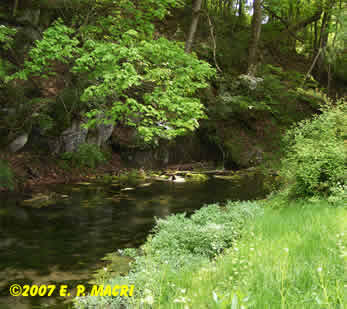Brown Trout Limestone Streams and Spring Creeks
by
Eugene Macri
Aquatic and Environmental Scientist
Fly fishing for brown trout in spring creeks use to produce some very large fish. This is especially true
in some Eastern Streams like the Letort (Letort Spring Run). But those days are gone. The
Pennsylvanian Fish and Boat Commission's own data show this to be true. There are a few fish in the 20
inch class but nothing like the time my friends Charlie Fox, Vince Marinaro, Ross Trimmer,
Gene Utech, and the King of the Letort, Ed Shenk fished the stream over 30 years ago.
These streams have been hit by development, pollution of all types, and lack of understanding on what it takes
to keep a limestone spring creek in top condition for fishing. Limestone spring creeks in the
states are very similar to English Chalk Streams. In order for these stream to be at their best in fishing they
must be managed, maintained and manicured for the trout and the fisherman. There is a major failure of fishery
agencies and natural resource agencies to understand spring creeks and the maintenance of them. They think
these streams can just be left alone like freestone streams. This is the furthest thing from the truth. The
Riverkeepers of England and Europe have known for years that these stream must be managed properly.
In England and Europe most of the Chalk Streams are brown trout streams. Brown  trout in limestone spring creeks are epitome of selective
fishing. These rich streams allow the fish to feed selectively because of the slower currents (less
energy used), cold water, and massive insect populations. Furthermore, the fish do not have the problems
associated with winter in a freestone stream of ice and near lethal water temperatures. In these spring creeks
the temperature regime is usually in the 46 to 56 degree range (photo to the left shows Big Spring Creek
Newville PA, a limestone spring creek). trout in limestone spring creeks are epitome of selective
fishing. These rich streams allow the fish to feed selectively because of the slower currents (less
energy used), cold water, and massive insect populations. Furthermore, the fish do not have the problems
associated with winter in a freestone stream of ice and near lethal water temperatures. In these spring creeks
the temperature regime is usually in the 46 to 56 degree range (photo to the left shows Big Spring Creek
Newville PA, a limestone spring creek).
Brown trout in spring creeks will feed intermittently and that's a problem for the fly angler. Because
they use less energy and there is food everywhere they can feed at any time. However, in recent years with the loss
of many hatches and duration of the hatches diminishing, brown trout are becoming more of night feeders. This
wasn't true over 30 years ago when these fish would feed right in the middle of the day. There is another problem
associated with this adaptation in feeding and that is that the browns may resort to feeding on minnows, sculpins
and other large organism earlier because of the diminished hatches. This is also occurring on Western spring creeks
too.
Of course, one might ask if there are so many nymphs and larvae in the stream why don't they just feed
underneath the water? They actually do more of this but taking adult flies probably uses less energy during a
time period in which they feed heavily. It takes more energy for a trout to properly grub for nymphs than it does
to hang under a slow current and just feed on fly after fly during a hatch. The fact is however contrary to
what many fly anglers have written is that the limestone spring trout don't have to feed that efficiently to
survive because there is so much food in the stream and they don't have to get through a winter season.
| 
